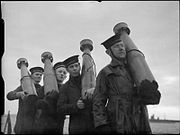

The Unrotated Projectile, or UP, was a short range rocket-firing anti-aircraft weapon developed for the Royal Navy to supplement the 2 pounder Pom-Pom gun due to a lack of close-range anti-aircraft weapons. It was used extensively by British ships during the early days of World War II. The UP was also used in ground-based single and 128-round launchers known as Z Batteries.
Operation[]
The name Unrotated Projectile comes from the fact that the projectile was not spin-stabilized. The weapon had 20 smoothbore tubes, fired ten at a time. A small cordite charge was used to ignite a rocket motor which propelled the fin-stabilized 7 inches (18 cm) diameter rocket out of the tube to a distance of about 1,000 feet (300 m) where it exploded and released an 8.4 ounces (240 g) mine attached to three parachutes by 400 feet (120 m) of wire. The idea was that an aeroplane hitting the wire would draw the mine towards itself where it would detonate.
Development[]
The UP was developed by Sir Alwyn Crow who was the director of the Projectile Development Establishment at Fort Halstead. In November 1939, Winston Churchill as First Lord of the Admiralty asked Dr. Crow to produce urgently a means of laying an aerial minefield and to consider other methods of protecting ships against aircraft. It is likely that Churchill was influenced in his request by his friend and advisor Frederick Lindemann who had previously advocated a scheme for "dropping bombs hanging by wires in the path of attacking aircraft".[1] A high-altitude barrage was developed: an aerial minefield up to 19,000 feet (5,800 m), the fast aerial mine up to 2,000 feet (610 m), the PE fuse up to 18,000 feet (5,500 m) and the UP up to 20,000 feet (6,100 m). All three services, including the Home Guard, used the UP in various forms.[2]
Effectiveness[]
The weapon was never very effective as aircraft could avoid the wires and was also slow to load; it was replaced later in the war by the 2 pounder or Bofors 40 mm gun.
A demonstration of the weapon for Churchill on Admiral Jack Tovey's flagship at Scapa Flow dramatically exposed a flaw in the concept. Practice bombs were fired and when there was an unexpected change of wind, they drifted back onto the ship and some became entangled in the rigging and superstructure. The dummy rounds caused little or no damage but Tovey was amused at the embarrassment thus caused to the weapon's advocates, Lindeman and Churchill.[3]
The UP ammunition aboard HMS Hood was seen to be on fire just before she exploded and sank in May 1941. The report of the Admiralty Board of Enquiry into the sinking of Hood in September 1941 concluded "That the fire that was seen on Hood's Boat Deck, and in which UP and/or 4-inch ammunition was certainly involved, was not the cause of her loss", but it noted that "Action has (already) been taken to land UP mountings and ammunition" in the rest of the fleet.[4]
Specifications[]
- Rocket length: 32 inches (810 mm)
- Rocket weight: 35 pounds (16 kg)
- Horizontal range: 3,000 feet (910 m)
- Sinking speed of mine: 16 to 23 feet per second (5 to 7 m/s).
- Mounting weight: 4 tonnes (4.0 t).
See also[]
- Z Battery : British 3-inch land-based anti-aircraft rocket launcher
- AA Mine Discharger, a Japanese anti-aircraft mortar.
- Holman Projector, a steam powered anti-aircraft grenade launcher.
References[]
Notes[]
- ↑ Furneaux-Smith, 1961, p210.
- ↑ Furneaux-Smith, 1961, p234.
- ↑ "Admiral of the Fleet Lord Tovey of Langton Matravers, G.C.B., K.B.E., D.S.O., D.C.L.". The Naval Review. July 1980. http://www.naval-review.org/issues/1980-3.pdf. Retrieved 5 August 2010.
- ↑ ADM 116/4351: Report on the Loss of H.M.S. Hood
Sources[]
- Furneaux-Smith, F. (1961). The Professor and the Prime Minister: The Official Life of Professor F. A. Lindemann Viscount Cherwell. Boston: Houghton Mifflin Company.
External links[]
| Wikimedia Commons has media related to Unrotated Projectile. |
- BBC : Memories of the Home Guard
- Tony DiGiulian, British UP AA Rocket Mark I
- HMS Hood Anti-Aircraft Armament
- Schermuly and his rockets
- British UP AA Rocket Mark I
| ||||||||||||||||||||||||||||||||||||||
The original article can be found at Unrotated Projectile and the edit history here.